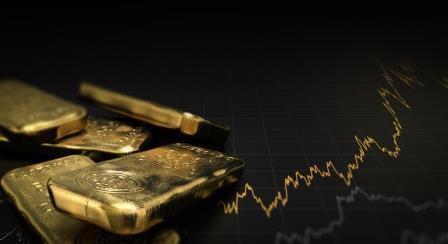Gold on the key London spot market declined to a six-month low on firm US dollar and a jump in Treasury yields. Hopes of interest rates staying higher for an unexpected period increased the demand for US assets. Despite a weaker Indian Rupee, domestic gold mirrored the trend with the most active MCX futures and shed it price to Rs 57500 per ten grams, its lowest level since March 2023.
Gold had a firm start this year by gaining more than 13 percent in the first five-month period. Since then, it consolidated in a tight range, and last week, it came out of the stiff support zone of $1880 an ounce.
Recently, gold prices have been primarily driven by real interest rates. As a long-term investment gold looks positive, but for the very short term it usually pays nothing. Short-term investors are attracted by higher real income by investing in government bonds and currency which make gold less attractive in relative terms.
Expectations that the higher US rates may continue for an unexpected period lifted the value of US assets. The real yield on the US 10-year treasury bond has headed higher this year and is now at a decade high. The US greenback was almost steady in the first two quarters but started gaining quickly. The dollar Index, which measures the value of US currency posted more than seven percent since mid-July and is currently placed well above the 106 level.
Gold and the U.S. dollar often have an inverse relationship. When the dollar strengthens, the price of gold in dollars typically falls, and vice versa. This inverse correlation is because gold is priced in U.S. dollars worldwide. When the dollar rises in value, it takes fewer dollars to buy the same amount of gold, leading to a decrease in the gold price.
A strong U.S. dollar can be associated with higher interest rates set by the U.S. Federal Reserve. Higher interest rates can make alternative investments, such as bonds and savings accounts, more attractive because they offer a higher return. When interest rates rise, the opportunity cost of holding non-interest-bearing assets like gold increases, which can lead to a decline in demand for gold.
Also, gold is often seen as a safe-haven asset. Investors tend to flock to gold during times of economic uncertainty or market turmoil. When the U.S. dollar is strong, it can signal confidence in the U.S. economy and financial markets, leading investors to move away from safe-haven assets and invest into riskier assets like stocks and bonds.
The holdings of gold-backed ETFs and similar products dropped to multi-year lows. The flows of EFTs are used to highlight the investors’ desire to park their money in gold. The holdings of SPDR Gold Trust, the world’s largest gold-backed Exchange Traded Fund recently dropped to four-year lows featuring less investment interest in the commodity.
Though a bleak investment demand outlook prevails in the metal, there are hopes of significant physical demand from key market drivers like India and China. Due to anxiety over the economy, there are reports of a surge in gold demand from China.
Looking ahead, the real US interest rates continue to put pressure on gold but prospects of a firm physical demand from China and India would limit major weakness in prices. There are reports that, due to the anxiety over the economy there is a surge in gold demand from China. During the first half of the year, gold bars and coins rose by almost 30 percent in the country. Likewise, as the key demand season is yet to start in India, the second-largest consumer of gold, may boost the domestic demand and thus support prices.
First published in The Economic Times









